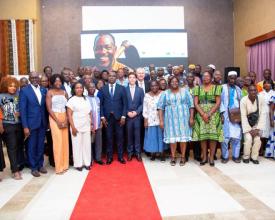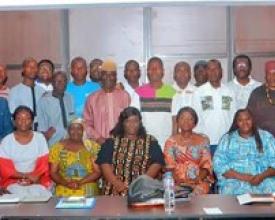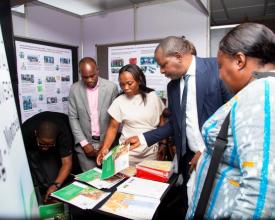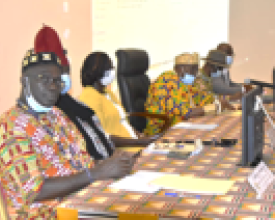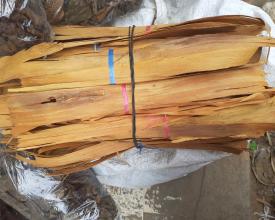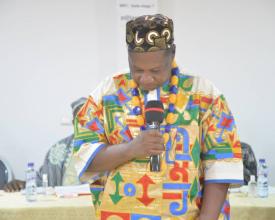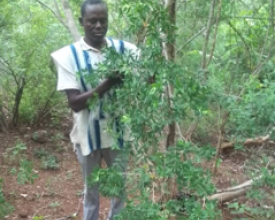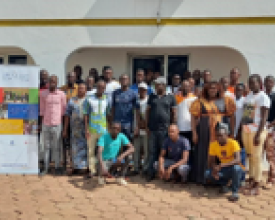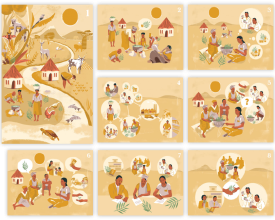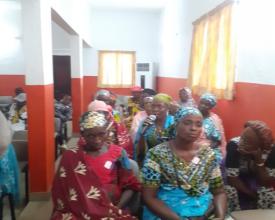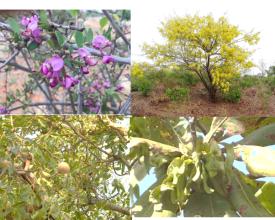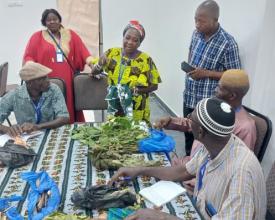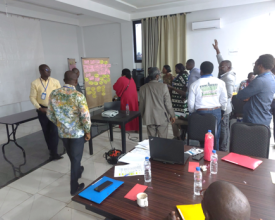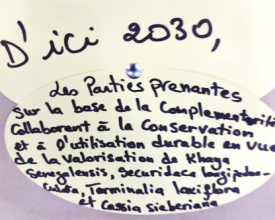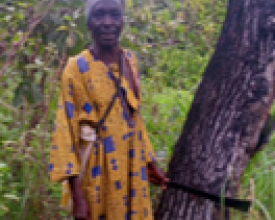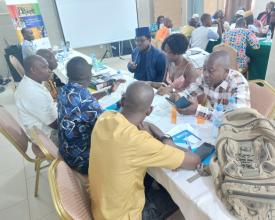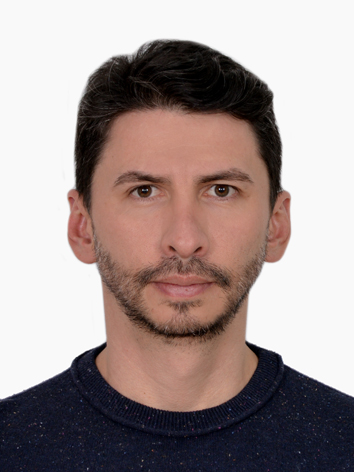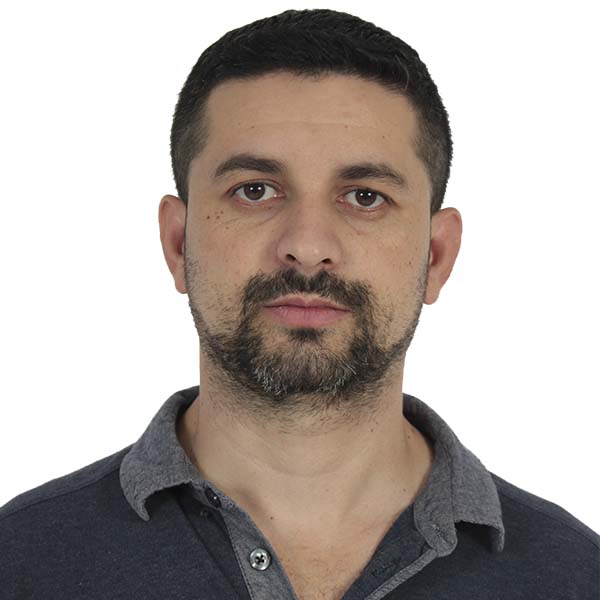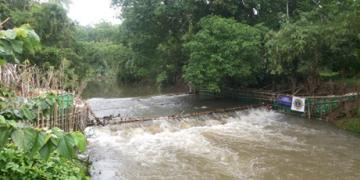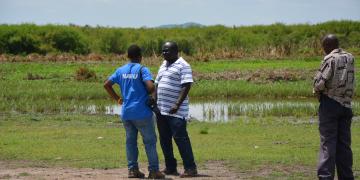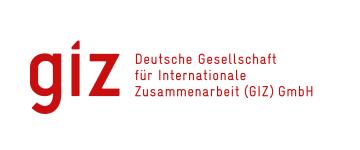
From Plants to Power: Integrating and Strengthening Community Voices in the Value Chain
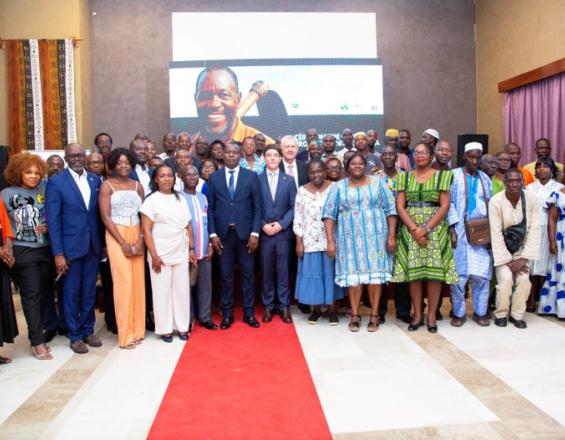
In Côte d’Ivoire, most local communities are barely involved in the valorisation of genetic resources like medicinal plants - beyond providing them as raw or minimally processed material. They are unaware of what happens to these resources beyond local markets.
This is compounded by deep-rooted mistrust, which can lead to community representatives not attending meetings. Thus, their resources are often used without their participation or them benefitting.
Improving the inclusion of local communities in valorisation has been a key pillar of the ABS Capacity Development Initiative. New approaches have led to promising results. In northeastern Côte d’Ivoire, the ABS Initiative piloted a model and successful integrated communities into the value chain for traditional medicine. The approach included engaging traditional and administrative authorities at every level, actively involving village residents, and using tools like picture cards and role-playing games, all while supporting the organisation of traditional healers.
Contexto
Défis à relever
Local communities in Côte d’Ivoire, for example around the Comoé Park in the northeast, were not involved in the valorisation of traditional medicine or related value chains - beyond being plant providers. They lacked awareness of what happens to their resources and had no access to training, resources, or institutional support to participate meaningfully. In some cases, they may even overuse medicinal plants due to a lack of alternatives or knowledge. Deep-rooted mistrust also prevented them from sharing traditional knowledge. Many were unaware of national regulations, such as Access and Benefit Sharing (ABS), designed to ensure fair benefit-sharing.
It became clear that common participation approaches would fail, resulting in raised expectations while ignoring culture, communication styles, and memories of past injustices.
The ABS Initiative therefore chose a different, more complex path: a long-term journey aimed at meaningfully integrating local communities into the value chain of traditional medicine.
Ubicación
Procesar
Summary of the process
The five building blocks form a sequenced, mutually reinforcing process. Starting with national-to-local authority engagement (BB1) secured cultural legitimacy and political backing, enabling direct community outreach. This prepared the ground for local ambassadors (BB2) to bridge between projects and villages, building trust and ownership. Illustrated cards and role games (BB3) translated complex ABS concepts into accessible, interactive learning, empowering participants to engage meaningfully. The multi-stakeholder platform (BB4) then brought communities, practitioners, researchers, and authorities together to co-create action plans, fostering collaboration and shared responsibility. Finally, strengthening local associations (BB5) gave communities a structured, collective voice in value chains, ensuring sustainability of outcomes. Each block builds on the previous one: authority endorsement enables outreach; outreach fuels informed participation; participatory tools deepen understanding; multi-stakeholder cooperation aligns interests; and associations anchor benefits in long-term, community-led structures.
Building Blocks
The journey - Informing all relevant authorities from national to local level to get their buy-in, permission, contacts and recommendations
The approach began at the national level, recognising the pivotal role of traditional leadership in community engagement. The National Chamber of Kings and Traditional Chiefs, representing 31 regions and thousands of villages, serves as a key communication channel between communities and the national government, even up to the presidency.
Together with the Ministry of Environment (MINEDDTE), an interactive workshop was held with ten kings to openly analyse the current context and co-design activities to better integrate local communities into the valorisation of biological resources. These sessions were not only informative but essential in shaping a locally grounded and culturally appropriate approach.
With official ministerial backing, the project engaged regional administrative representatives, followed by administrative and traditional authorities in northeastern Côte d’Ivoire, especially near Bouna and Dabakala.
At each level, interactive, participatory methods tailored to local realities were used. Authorities expressed support, shared insights, and provided key contacts. Their involvement enabled direct outreach to communities and laid the foundation for their participation in the value chains on medical plants.
Enabling factors
A key enabler was the strong collaboration with the Ministry of Environment (MINEDDTE), including official invitations and input from the ABS Focal Point. Another success factor was the use of interactive methods, in particular the CAP-PAC method that fostered understanding, exchange, and reflection, as well as videos, and illustrated cards. These tools helped explain ABS and value chains clearly and encouraged active participation, especially during workshops with the National Chamber of Kings and Traditional Chiefs and other authorities.
Lesson learned
A key lesson from this approach is the critical importance of understanding and engaging traditional structures. These local authorities are central to community dynamics and decision-making. Their active involvement and consent are essential for any initiative to succeed.
Traditional leaders bring valuable local knowledge, contacts, and cultural insight. Just as importantly, their endorsement builds trust and legitimacy within communities. Without their support, even well-designed projects risk resistance or limited impact. The CAP-PAC method effectively fosters mutual understanding, uncovers underlying interests, and helps find practical solutions.
Inclusive and respectful collaboration with traditional authorities requires dedicated space for dialogue and shared ownership. Joint workshops across regions, conducted in partnership with the Ministry of Environment of Côte d’Ivoire, proved essential for building trust, aligning institutions, and ensuring credibility and sustainability of the approach.
Involving local ambassadors
The key game changer in the process was the inclusion of young community members, known as animateurs, who had been identified by GIZ’s bilateral Pro2GRN project, active in the Comoé region. Already engaged in local outreach, these animateurs supported the transfer of project ideas to village level. With their strong standing in local structures, they facilitate internal discussion of GIZ ideas, fostering local ownership without GIZ presence.
In collaboration with the Ministry of Environment, the ABS Initiative conducted a workshop with around 40 animateurs. Using illustrated cards and role games, they were trained on key issues of valorising biological resources and ABS processes in an interactive, playful way.
The animateurs also developed initial criteria to identify local representatives for upcoming workshops. Over the next three months, they reached around 250 villages, raising awareness, helping communities select around 100 workshop participants. They provided crucial assistance with translating information and actions into local languages.
During the workshops, the animateurs facilitated group activities, led role games, translated, and enabled open, participatory dialogue on genetic resources, traditional knowledge, community needs, effective value chain participation and ABS.
Enabling factors
Enabling factors included:
- Existing links between a GIZ project and animateurs in northeastern Côte d’Ivoire, which facilitated outreach and knowledge transfer.
- The animateurs themselves, who fostered ownership in the valorisation of biological resources and ABS knowledge, supported participant selection, and increased communities’ interest in becoming involved.
- Illustrated cards and role games, which made complex content accessible and engaging for local communities.
Lesson learned
Engaging younger residents as facilitators was key to fostering ownership, trust, and sustained participation in value chains on traditional medicine and ABS processes. The sensibilisation these animateurs on valorisation of biological resources and ABS clearly led to increased communities’ interest and without the animateurs, inclusion of community members - especially traditional knowledge holders, who rarely share their knowledge with outsiders - would have been much more difficult.
Interactive training methods that are easy to understand and overcome language barriers proved essential for effective knowledge transfer and empowerment.
Efforts to achieve gender balance among animateurs however largely reflected local realities: only 2 of 36 were female, highlighting ongoing challenges in women’s participation.
Illustrated cards and role games
The use of illustrated cards
Natural Justice was commissioned to develop a set of eight illustrated cards and a facilitator manual to support local communities in understanding ABS processes. Designed for use in low-literacy, multilingual settings, these cards simplify complex topics like the value of genetic resources, value chains, and benefit-sharing agreements. This visual tool encourages dialogue enabling local communities to engage meaningfully in ABS discussions. Only the images are shown to participants, while the manual helps facilitators explain each concept and ask the right questions.
The cards allow community members to connect the content to their own lives strengthening ownership.
The use of role games
Role games help communities understand complex processes, such as ABS by simulating real-life access requests to local resources. Participants act out roles, being community members, government, and users (e.g., companies) to practice negotiations, benefit-sharing, and communication. Performed in local languages, the sketch is repeated until key ABS steps are correctly represented, helping embed knowledge through active participation. It should be explained that the role play is to illustrate how the procedure just explained works in practice. The script is explained to all participants before the sketch begins.
Enabling factors
It was essential to develop the illustrated cards in advance and ensure that each participant received a complete set. The moderators were trained beforehand on the specific questions to ask with each card and on the relevance of each card to ABS. Likewise, it was important that representatives of the local communities were familiar with role-playing techniques and had practised them in advance.
Lesson learned
Using illustrated cards and repeated role games proved essential in enabling meaningful community engagement in ABS processes and value chain partnerships. These tools created space for real interaction, supported by local animateurs who facilitated translation and cultural relevance. The cards helped demystify complex ABS concepts, making them accessible to all participants.
A key success factor was the repeated role play, especially the participatory element where community members could correct intentionally “wrong” performances. This deepened understanding and ownership of the ABS process, as confirmed by oral feedback and monitoring before and after the workshops.
Developing a multi-stakeholder platform to ensure continued progress and sustained commitment
To advance the development of a value chain, a multi-stakeholder platform (MSP) was established. In the field of traditional medicine, it included representatives of local communities, traditional practitioners and/or small enterprises, researchers, and national government actors.
The first meeting introduced participants, clarified their roles and contributions, and allowed space to discuss interests, expectations, needs, and challenges. It also served to define strategic directions and a shared vision for the platform.
In a second workshop, stakeholders were trained by experts in the valorisation of traditional medicine- from plant to product- covering sustainable use, market access, toxicity testing, quality standards, and other key steps in building a viable value chain.
The third MSP meeting focused on building trust through intensive dialogue and the development of a joint action plan as well as a written agreement outlining each group’s roles and responsibilities.
The process was supported by a study on the availability and sustainable use of selected medicinal plants.
Joint results were presented to the Ministry of Environment during a public event with all stakeholders, media, a mini-exhibition, product displays, and a short video featuring community feedback.
Enabling factors
Key success factors included: a series of interactive workshops with sufficient time for a deep exchange on roles and responsibilities; eye-opening inputs from expert from local and West African practitioners on all the requirements to valorise medicinal plants; open and honest dialogue fostering trust; a high-level event to showcase results in front of the minister of environment and the TV; and the patience and dedication of moderators ensuring all voices were heard and respected.
Lesson learned
Creating a multi-stakeholder process, especially one involving local communities, requires time and well-structured, interactive sessions. Continuity through regular workshops is essential. Moderators must ensure ongoing engagement, respect all voices, and value each contribution. Activities like valorisation training, offering new insights, are vital.
Joint plans and written agreements are only possible once trust has been established. This trust requires repeated, open, and sometimes intense discussions. For example, defining roles led to deep exchanges between communities, traditional healers, and researchers. As communities realized they had need to contribute, even share protected knowledge, fears had to be voiced - and some discussions ran until 10:30 p.m. These moments were crucial to clarify short-term outcomes and what needs more time.
The government’s role remained a point of contention, as national authorities saw themselves not as partners, but as decision-makers due to their financial role.
Strengthening local communities’ structures to improve the effectivity and capacities of local actors being part of a value chains on traditional medicine
While the creation of local associations is a common GIZ approach to strengthen local voices and support trade in raw materials and products, it requires careful coordination with regional authorities and a clear step-by-step process. In northeast Côte d’Ivoire, before engaging local communities, a meeting was held with prefects, sub-prefects, political representatives, and members of an existing successful association of traditional medicine practitioners. The association shared why it was formed and what it had achieved, leading to buy-in and support from local authorities.
In the second step, a workshop gathered traditional medicine practitioners from regional villages. The existing association again shared its process and results, inspiring other practitioners. However, tensions between established practitioners and those with different approaches who are not yet organised were acknowledged. Care needs to be taken to ensure that the association-building process remained inclusive and balanced.
In the third step, practitioners took this knowledge back to their communities, where they discussed the association’s structure and their involvement with local decision-makers. The process is supported by a sister GIZ project active on the ground.
Enabling factors
Enabling factors included: following a clear sequence by first informing authorities to gain support; leveraging existing contacts through a GIZ sister project; showcasing a successful association to demonstrate steps and benefits; applying a sensitive, balanced approach during workshops with diverse traditional medicine practitioners; and ensuring the process was brought back to local communities and their decision-making structures before forming associations.
Lesson learned
A key lesson is that informed buy-in and support from local authorities and politicians is essential before directly engaging traditional medicine practitioners. This is best achieved by involving a successful existing association and a sister project with established contacts to authorities.
Another lesson is that not all practitioners fully support the idea of a joint association. Differences in methods and levels of recognition can create tensions. Addressing these differences with sensitivity is crucial to avoid perceptions of exclusion.
Finally, decisions are made within local community structures, not solely by practitioners. The formation of a broader association across villages is carefully considered at the community level. Having a sister GIZ project—or another trusted local partner - actively involved on the ground is a major advantage for guiding and supporting this process.
Impacts
This long-term, participatory approach has led to various impacts in northeastern Côte d’Ivoire. First, local communities have become aware of the true value of their medicinal plants and associated traditional knowledge. They now understand their legal right to negotiate both monetary and non-monetary benefits when granting access to these resources and knowledge - shifting from passive suppliers to empowered stakeholders.
Second, through consistent involvement in workshops on partnerships and association-building, community members gained confidence and clarity on their rights, roles, and responsibilities. Continuous engagement and respectful dialogue created space for them to express their perspectives and actively shape outcomes. This led to increased ownership of the process and recognition that it is not a top-down intervention but one centered on their long-term interests.
Most importantly, communities are now formal partners in a joint value chain for traditional medicine and knowledge. This inclusive, collaborative model is more effective than fragmented, siloed approaches and opens access to better-targeted markets. As a result, economic benefits for local communities are expected to grow significantly - through improved product valorisation, stronger bargaining power.
A recent assessment of medicinal plants will encourage local communities to use their resources more sustainably.
Beneficiaries
Key beneficiaries are local community representatives and traditional medicine practitioners. Once mere suppliers of raw materials, they now have a voice in partnerships. Researchers also benefit from improved access to resources and direct provider contact.
Global Biodiversity Framework (GBF)
Sustainable Development Goals
Story
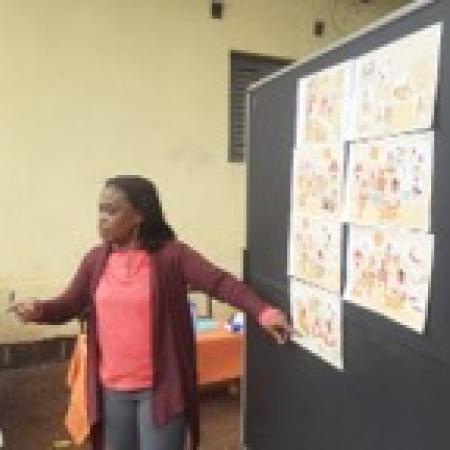
Roots of Change: A Journey of Partnership and Purpose in Comoé
In 2021, a quiet journey began - not with headlines, but with handshakes and conversations. The aim: to implement Access and Benefit Sharing (ABS), ensuring communities are fairly recognised when their traditional knowledge and biological resources are used. The principle was clear; the practice would require trust.
We began by meeting traditional leaders - the National Chamber of Kings and Chiefs - whose trust was essential. Navigating the country’s layered authority structures took time, listening, and humility. Our initial plan covered five regions, but we soon realised that wide reach could mean shallow results. So, we shifted focus to one region, Comoé, rich in biodiversity and tradition.
There, our real work started. We met local chiefs, elders, mayors, and healers. Many hadn’t heard of ABS. They asked: Will our knowledge be protected? Will we be forgotten? We didn’t have all the answers, but we made a commitment: to walk together.
Progress was slow but steady. Then a spark: a bilateral GIZ project highlighted the importance of traditional medicine, reinforcing our belief in local knowledge. Together, we saw the need for community leadership, not just participation. We trained local youth as “animators”, bridging tradition and change. Using games, visuals, and workshops, we empowered them to bring ABS to life in their villages.
In one workshop, communities selected four key plants—used for healing, rituals, and nourishment—to include in future ABS value chains. This act of choosing marked a turning point: ABS was becoming theirs.
Momentum grew. We held multi-stakeholder workshops uniting government, researchers, traditional healers, and villagers. A joint action plan and cooperation agreement followed—co-created and signed by all. ABS now had local faces and stories.
To this day, no community has dropped out. They stay engaged because they believe in the process. Trust has sparked ownership; hesitation has become pride. Community members now speak up, negotiate, and lead.
This success didn’t come from top-down efforts but from listening and inclusion.
